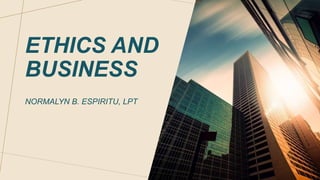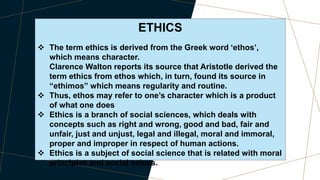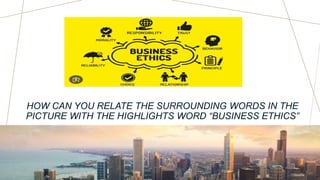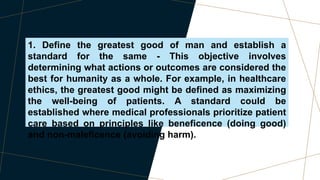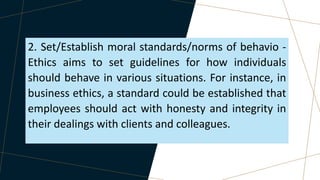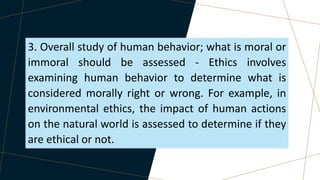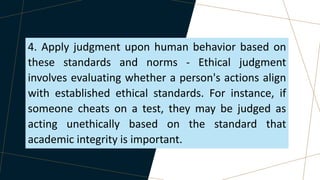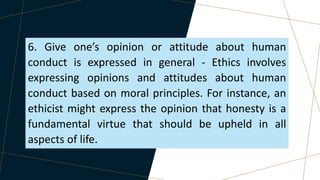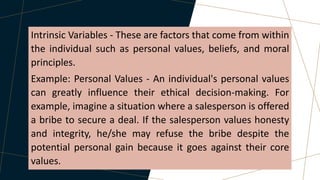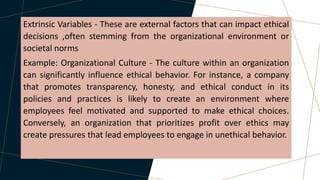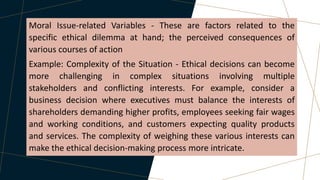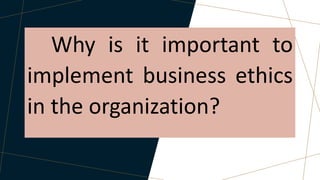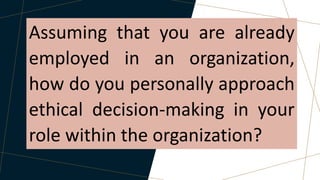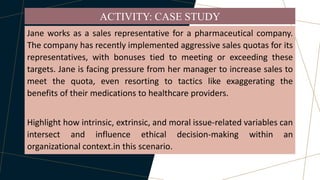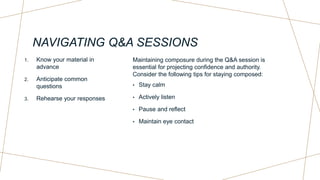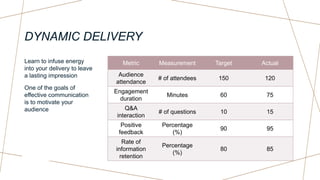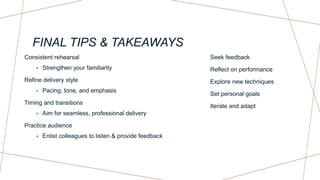OBJECTIVES-OF-ETHICShsbhvhasvhvhavavann.pptx
- 1. ETHICS AND BUSINESS NORMALYN B. ESPIRITU, LPT
- 2. AGENDA OBJECTIVES: ’āśDefine Business Ethics ’āśDiscuss the Objectives of Ethics ’āśExplain the Factors to be Considered in Making Ethical Decisions
- 3. ETHICS ’üČ The term ethics is derived from the Greek word ŌĆśethosŌĆÖ, which means character. Clarence Walton reports its source that Aristotle derived the term ethics from ethos which, in turn, found its source in ŌĆ£ethimosŌĆØ which means regularity and routine. ’üČ Thus, ethos may refer to oneŌĆÖs character which is a product of what one does ’üČ Ethics is a branch of social sciences, which deals with concepts such as right and wrong, good and bad, fair and unfair, just and unjust, legal and illegal, moral and immoral, proper and improper in respect of human actions. ’üČ Ethics is a subject of social science that is related with moral principles and social values.
- 4. HOW CAN YOU RELATE THE SURROUNDING WORDS IN THE PICTURE WITH THE HIGHLIGHTS WORD ŌĆ£BUSINESS ETHICSŌĆØ
- 5. Business Ethics/Corporate Ethics - are practically concerned with the entire scope of functions of an organization which scrutinizes and sets the codes related to the moral/ethical principle to find the solutions to the problems faced by an employee in specific and the organization in general. It can be termed as a study of proper business policies and practices regarding potentially controversial issues, such as corporate governance, insider trading, bribery, discrimination, corporate social responsibility, and fiduciary responsibilities. Law often guides business ethics, while other times business ethics provide a basic framework that businesses may choose to follow to gain public acceptance.
- 6. OBJECTIVES OF ETHICS ŌĆó 1.Define the greatest good of man and establish a standard for the same. ŌĆó 2.Set/Establish moral standards/norms of behavior. ŌĆó 3.Overall study of human behavior; what is moral or immoral should be assessed. ŌĆó 4.Apply judgment upon human behavior based on these standard and norms. ŌĆó 5.Suggest moral behavior, Prescribes recommendations about DoŌĆÖs and DonŌĆÖts. ŌĆó 6.Give oneŌĆÖs opinion or attitude about human conduct is expressed in general.
- 7. 1. Define the greatest good of man and establish a standard for the same - This objective involves determining what actions or outcomes are considered the best for humanity as a whole. For example, in healthcare ethics, the greatest good might be defined as maximizing the well-being of patients. A standard could be established where medical professionals prioritize patient care based on principles like beneficence (doing good) and non-maleficence (avoiding harm).
- 8. 2. Set/Establish moral standards/norms of behavio - Ethics aims to set guidelines for how individuals should behave in various situations. For instance, in business ethics, a standard could be established that employees should act with honesty and integrity in their dealings with clients and colleagues.
- 9. 3. Overall study of human behavior; what is moral or immoral should be assessed - Ethics involves examining human behavior to determine what is considered morally right or wrong. For example, in environmental ethics, the impact of human actions on the natural world is assessed to determine if they are ethical or not.
- 10. 4. Apply judgment upon human behavior based on these standards and norms - Ethical judgment involves evaluating whether a person's actions align with established ethical standards. For instance, if someone cheats on a test, they may be judged as acting unethically based on the standard that academic integrity is important.
- 11. 5. Suggest moral behavior, prescribe recommendations about DoŌĆÖs and DonŌĆÖts: Ethics provides guidance on what actions are considered morally acceptable (DoŌĆÖs) and unacceptable (DonŌĆÖts). For example, in medical ethics, a doctor may be advised to always obtain informed consent from patients before performing a procedure (Do) and to never disclose confidential patient information without consent (DonŌĆÖt).
- 12. 6. Give oneŌĆÖs opinion or attitude about human conduct is expressed in general - Ethics involves expressing opinions and attitudes about human conduct based on moral principles. For instance, an ethicist might express the opinion that honesty is a fundamental virtue that should be upheld in all aspects of life.
- 13. Factors to be Considered in Making Ethical Decisions
- 14. Intrinsic Variables - These are factors that come from within the individual such as personal values, beliefs, and moral principles. Example: Personal Values - An individual's personal values can greatly influence their ethical decision-making. For example, imagine a situation where a salesperson is offered a bribe to secure a deal. If the salesperson values honesty and integrity, he/she may refuse the bribe despite the potential personal gain because it goes against their core values.
- 15. Extrinsic Variables - These are external factors that can impact ethical decisions ,often stemming from the organizational environment or societal norms Example: Organizational Culture - The culture within an organization can significantly influence ethical behavior. For instance, a company that promotes transparency, honesty, and ethical conduct in its policies and practices is likely to create an environment where employees feel motivated and supported to make ethical choices. Conversely, an organization that prioritizes profit over ethics may create pressures that lead employees to engage in unethical behavior.
- 16. Moral Issue-related Variables - These are factors related to the specific ethical dilemma at hand; the perceived consequences of various courses of action Example: Complexity of the Situation - Ethical decisions can become more challenging in complex situations involving multiple stakeholders and conflicting interests. For example, consider a business decision where executives must balance the interests of shareholders demanding higher profits, employees seeking fair wages and working conditions, and customers expecting quality products and services. The complexity of weighing these various interests can make the ethical decision-making process more intricate.
- 17. Why is it important to implement business ethics in the organization?
- 18. Assuming that you are already employed in an organization, how do you personally approach ethical decision-making in your role within the organization?
- 19. "In the end, you're measured not by how much you undertake but by what you finally accomplish." - Donald Trump
- 20. Jane works as a sales representative for a pharmaceutical company. The company has recently implemented aggressive sales quotas for its representatives, with bonuses tied to meeting or exceeding these targets. Jane is facing pressure from her manager to increase sales to meet the quota, even resorting to tactics like exaggerating the benefits of their medications to healthcare providers. Highlight how intrinsic, extrinsic, and moral issue-related variables can intersect and influence ethical decision-making within an organizational context.in this scenario. ACTIVITY: CASE STUDY
- 21. EFFECTIVE DELIVERY TECHNIQUES Effective body language enhances your message, making it more impactful and memorable. ŌĆó Meaningful eye contact ŌĆó Purposeful gestures ŌĆó Maintain good posture ŌĆó Control your expressions This is a powerful tool in public speaking. It involves varying pitch, tone, and volume to convey emotion, emphasize points, and maintain interest. ŌĆó Pitch variation ŌĆó Tone inflection ŌĆó Volume control
- 22. NAVIGATING Q&A SESSIONS 1. Know your material in advance 2. Anticipate common questions 3. Rehearse your responses Maintaining composure during the Q&A session is essential for projecting confidence and authority. Consider the following tips for staying composed: ŌĆó Stay calm ŌĆó Actively listen ŌĆó Pause and reflect ŌĆó Maintain eye contact
- 23. SPEAKING IMPACT Your ability to communicate effectively will leave a lasting impact on your audience Effectively communicating involves not only delivering a message but also resonating with the experiences, values, and emotions of those listening
- 24. DYNAMIC DELIVERY Learn to infuse energy into your delivery to leave a lasting impression One of the goals of effective communication is to motivate your audience Metric Measurement Target Actual Audience attendance # of attendees 150 120 Engagement duration Minutes 60 75 Q&A interaction # of questions 10 15 Positive feedback Percentage (%) 90 95 Rate of information retention Percentage (%) 80 85
- 25. FINAL TIPS & TAKEAWAYS Consistent rehearsal ŌĆó Strengthen your familiarity Refine delivery style ŌĆó Pacing, tone, and emphasis Timing and transitions ŌĆó Aim for seamless, professional delivery Practice audience ŌĆó Enlist colleagues to listen & provide feedback Seek feedback Reflect on performance Explore new techniques Set personal goals Iterate and adapt
- 26. SPEAKING ENGAGEMENT METRICS Impact factor Measurement Target Achieved Audience interaction Percentage (%) 85 88 Knowledge retention Percentage (%) 75 80 Post-presentation surveys Average rating 4.2 4.5 Referral rate Percentage (%) 10 12 Collaboration opportunities # of opportunities 8 10
